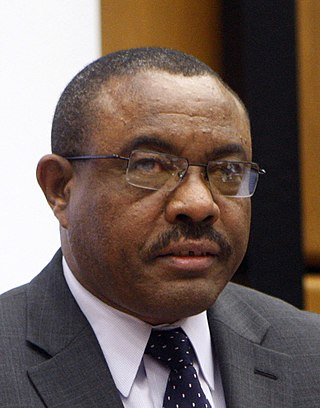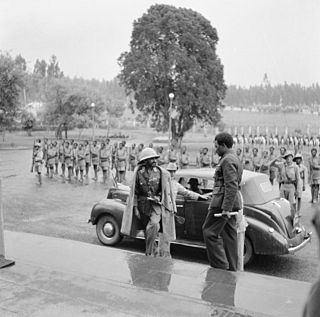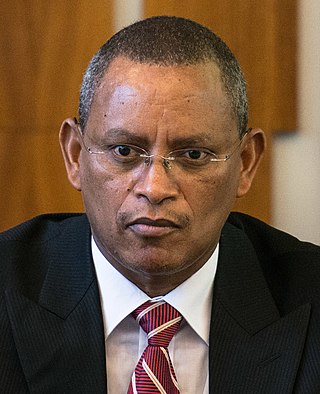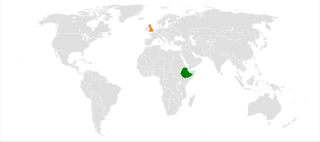Telecommunications in Ethiopia is a monopoly in the control of Ethio telecom, formerly the Ethiopian Telecommunications Corporation (ETC). As of 2012, 20.524 million cellular phones and 797,500 main line phones were in use.

The foreign relations of Ethiopia refers to overall diplomatic relationship of Ethiopia. The Ministry of Foreign Affairs oversees foreign relations and diplomatic missions of the country.

Haile Selassie I was Emperor of Ethiopia from 1930 to 1974. He rose to power as Regent Plenipotentiary of Ethiopia (Enderase) for Empress Zewditu from 1916. Haile Selassie is widely considered a defining figure in modern Ethiopian history, and the key figure of Rastafari, a religious movement in Jamaica that emerged shortly after he became emperor in the 1930s. Before he rose to power he defeated Ras Gugsa Wole Bitul of Begemidr at the Battle of Anchem in 1928. He was a member of the Solomonic dynasty, which claims to trace lineage to Emperor Menelik I, believed to be the son of King Solomon and Makeda, the Queen of Sheba.

Addis Ababa is the capital and largest city of Ethiopia. In the 2007 census, the city's population was estimated to be 2,739,551 inhabitants. Addis Ababa is a highly developed and important cultural, artistic, financial and administrative centre of Ethiopia.

Addis Ababa University (AAU) is a national university located in Addis Ababa, Ethiopia. It is the oldest university in Ethiopia. AAU has thirteen campuses. Twelve of these are situated in Addis Ababa, and one is located in Bishoftu, about 45 kilometres (28 mi) away. AAU has several associated research institutions including the Institute of Ethiopian Studies. The Ministry of Education admits qualified students to AAU based on their score on the Ethiopian University Entrance Examination (EUEE).

Oromia is a regional state in Ethiopia and the homeland of the Oromo people. The capital of Oromia is Addis Ababa.

The 1962 African Cup of Nations was the third edition of the Africa Cup of Nations, the soccer championship of Africa (CAF). It was hosted by Ethiopia. Nine countries entered the competition, including the reigning champions Egypt, meaning for the first time a qualification tournament was required. The finals only included four teams. Egypt, as holders, and Ethiopia as hosts, qualified automatically meaning each needed to play only one game to reach the final. Ethiopia won the tournament for the first time, defeating UAR 4-2, after extra time in the final.

Hailemariam Desalegn Boshe is an Ethiopian politician who served as prime minister of Ethiopia from 2012 to 2018. He also previously served as deputy prime minister and Minister of Foreign Affairs under Prime Minister Meles Zenawi from 2010 to 2012. After Meles' death in August 2012, Hailemariam succeeded him as prime minister, initially in an acting capacity. He was then elected as the chair of the EPRDF, the ruling party, on 15 September 2012. Hailemariam also served as the chairperson of the African Union from 2013 to 2014.
Articles related to Ethiopia include:

The military history of Ethiopia dates back to the foundation of early Ethiopian Kingdoms in 980 BC. Ethiopia has been involved in many of the major conflicts in the horn of Africa, and was one of the few native African nations which remained independent during the Scramble for Africa, managing to create a modern army. 19th and 20th century Ethiopian Military history is characterized by conflicts with the Dervish State, Mahdist Sudan, Egypt, and Italy, and later by a civil war.

The history of Addis Ababa, capital of Ethiopia, formally begins with the founding of the city in the 19th century by Ethiopian Emperor Menelik II and his wife Empress Taytu Betul. In the Middle Ages, Addis Ababa depicted as a fortified city named "Barara", and served as residence of Emperor of Ethiopian Empire until Dawit II. It was totally plundered by Adalite general Ahmed Gran in 1529, at the onset of Ethiopian–Adal War.

Italians of Ethiopia are Ethiopian-born citizens who are fully or partially of Italian descent, whose ancestors were Italians who emigrated to Ethiopia starting in the 19th century during the Italian diaspora, or Italian-born people in Ethiopia.

Italian Ethiopia, also known as the Italian Empire of Ethiopia, was the territory of the Ethiopian Empire which was occupied by Italy for approximately five years. Italian Ethiopia was not an administrative entity, but the formal name of the former territory of the Ethiopian Empire which now constituted the Governorates of Amhara, Harar, Galla-Sidamo, and Scioa after the establishment of Italian East Africa.

Debretsion Gebremichael is an Ethiopian politician and the chairman of Tigray People's Liberation Front (TPLF) he was also the president of the Tigray Region. His position as titular head of the Tigray Region was disputed by the federal government of Ethiopia who in November 2020 appointed Mulu Nega as the chief executive of the Transitional Government of Tigray, succeeded by Abraham Belay. Since July 2021, Debretsion leads again the Tigray Region, while Abraham Belay left the transitional government to become Ethiopia's minister of Defence.
Muktar Kedir is an Ethiopian politician who was President of the Oromia Region, the country's largest region, from 18 February 2014 to 20 September 2016.

Brazil–Ethiopia relations are the current and historical relations between the Federative Republic of Brazil and the Federal Democratic Republic of Ethiopia. Both nations are members of the Group of 77 and the United Nations.

Menelik Wossenachew was an Ethiopian singer who was known for his famous singles "Fikir Ayarejim", "Sukar Sukar" "Teyaqiyew Biaschegregn " and later "Gash Jembere".

During World War I, Ethiopia briefly forged an alliance with the Allied Powers, following Italy's entry into the war in 1915. In June 1916, a dynastic conflict emerged when the uncrowned Emperor, Lij Iyasu, was alleged to have converted to Islam under the influence of the Ottoman Empire, which led him to be charged with apostasy. As a result, then-regent Ras Tafari Mekonnen, later known as Emperor Haile Selassie, orchestrated a coup d'état in September, deposing Lij Iyasu and installing Empress Zewditu on the throne. Throughout the war, Empress Zewditu maintained a stance of neutrality.

Ethiopia–United Kingdom relations are bilateral relations between Ethiopia and the United Kingdom. Currently, Ethiopia has an embassy in London and United Kingdom has an embassy in Addis Ababa. Historically, their relations traced over centuries covered a range of areas including, but not limited to, trade, culture, education and development cooperation. The UK is the first country to open its embassy in Addis Ababa. Ethiopia is the first African country to open embassy in London.

This is a chronology of the lifetime of Ethiopian Emperor Haile Selassie.





















